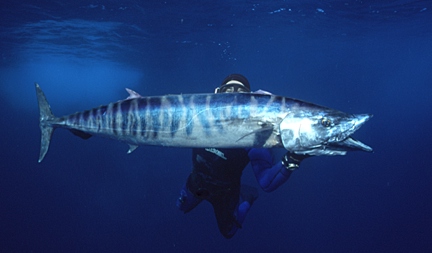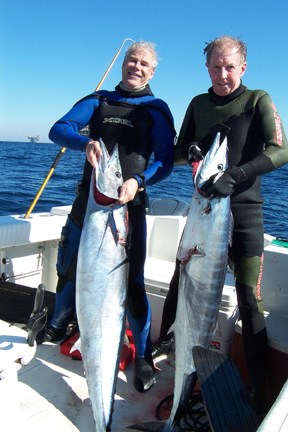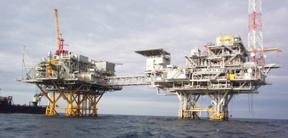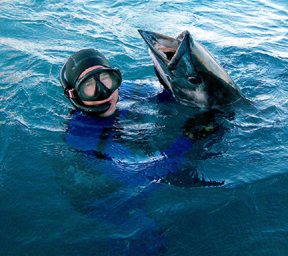|
Cajin Wahoo A 93-pound taken by the author off the mouth of the
Mississippi in January. “Blue water game
fish off the mouth of the Mississippi in January”, you’ve got to be
joking! Unbelievably, between winter storms this area is by far the best
blue water gamefish spot in the entire US. Wham! The fat wahoo
disappeared in a blur stretching my bungee and taking my first float
under. My foam-filled lifeguard floats are designed so that when the first
float descends, it releases 100 feet of Kevlar line before the second
float. This works perfectly to cushion the pull back pressure exerted on
the spearhead, which helps to limit tearing skin and flesh on the fish’s
first and usually strongest run. Since each successive run is generally
weaker, I knew that I could begin to recover the fish in less than 10
minutes. In the event of a strong run, I planned to hang onto the last
float which would release another 100 feet of line, plenty to play the
soft-fleshed wahoo. I gingerly pulled the fish in close enough to inspect
the position of the spearhead, which had toggled near the mid
section—not much chance of losing this guy. Packs of wahoo patrol the up
current, outside edge of baitfish schools. They often make a circuit while
cruising the outside of the bait. They will disappear at one edge of the
bait, loop out to sea and reappear at the other edge of the bait school.
This trait offers a good strategy for blue water hunters. Stay positioned
at the head of the bait at the depth of the fish—20- to 40-feet— and
wait until you can spot them as they return head on. It is common to hear
swish-boom as the bait flee in a panicked run to the safety of whatever
structure protects them. Wahoo strike bait from below with incredible
bursts of speed. I witnessed
such an attack in Mexico where a streaking wahoo shot up through a school
like a Polaris missile. Its razor teeth cleanly severed a fish as it shot
past in a blur. Lazily the “hoo” turned and ate each piece. Obeying
the ocean’s rule that everything gets eaten sooner than later, the
bait’s family greedily snatched up floating morsels of their dearly
departed. As the wahoo sunk to the depths, the water was scrubbed of
scraps and the bait returned to its random milling as if nothing untoward
had happened. Hunting these fish is similar to other locales. The smaller, more curious fish approach readily in shallow water. The wary lunkers lurk below at 40- to 50-feet. While my dive buddy Bob Jackson was suiting up at our first spot, I had time to leisurely scout the school. I mingled with the curious youngsters all the while keeping track of the larger fish below. These fish actually became a little friendlier with my repeated dives. My favorite technique is to drop silently to depth on the back of the big ones. Often they will slither away only to turn at 30 feet out to make a slow head-on return.
Terry and
his long time buddy Bob Jackson with The trip starts at the embarkation port town of Venice, Louisiana—a short 1 and 1/2 hour drive from New Orleans. Two industries, the smaller fishing and giant oil industry, keep the town alive. The oil industry and fishermen seem to work well together. The mouth of the Mississippi is a giant swamp, ideal for wildlife including wintering ducks. On a day too rough for the ocean, we rented a propeller boat and blew across this marshy wonderland complete with falcons, ducks, deer and fish. Oil tenders constantly maintain old capped wells to minimize the impact of leaks. The offshore platforms provide a fish bonanza for both bottom fish and migratory species. Even lobster crawl 200 feet and more up the platforms to settle into nooks and crannies.
Offshore
oil rigs attract bait and blue water gamefish, especially wahoo Daredevil scuba
spearfishers—rodeo divers— make 100- to 200-feet dives for amberjack
and grouper, fish so strong they have wrapped and drowned the unlucky.
Imagine a streaking 100-pound amberjack winding you up in your line
against a pier like a spider webs a fly. Fortunately, the well equipped
freedivers are less apt to get into trouble because they can separate
quickly from their gear and pelagic fish are less likely to involve the
rig because we hunt them several hundred feet away. The midnight lumps are
submerged salt domes rising out of thousands of feet of water just 17
miles out of the mouth of the Mississippi. The Mississippi drains rivers
from 31 states representing runoff from 41% of the continental US. For
eons these domes have been the breeding grounds for huge wahoo, and the
feeding grounds for blackfin tuna, yellowfin tuna and sharks—hammerheads
and makos. While there is good
year-round fishing off the mouth of the Mississippi, the early winter
months of December through March are the best for blue water gamefish.
Calm seas and water visibility and are the key factors for success. The
obvious source of dirty cold water is the river; the gulf water is clear.
It is eerie to dive through 15 feet of frigid 50-degree dirty river water
into 70-degree clear water. It reminds me of that hair raising feeling you
get when you dangle your bare legs from the swim step into blue water. Diving offshore during the
winter is a weather game. The best way to dive this area is to pick an
entire week and hope for one or two good days. Typically, winter storm
winds, which bring in off-color water, pound in from the Northwest.
However, it clears after a South wind and to some extent, after a wind
from the Northeast. The water also tends to clear over the lump during an
in coming tide. My average success rate for trips planned and actually
completed is about 25%. On the off days, you can drive to New Orleans or
ride an airboat into the swampy river mouth. The marshes are full of life;
ducks, deer, fish and falcons scatter as you zoom over the reeds at 30
mph. On a typical
too-windy-to-dive day, we walked along the docks and chatted with a
charter boat captain who proudly demonstrated his homemade
garbage-disposal chumming machine he rates at pounds/minute. Each boat
carries 100 pounds of pogies and a meat grinder. On average, tuna and game
fishermen catch another 100 pounds of bait, which they grind. On a good
day, there are upwards of 200 vessels anchored on the lumps churning out
an incredible 40,000 pounds or 20 tons of pureed shark lure. Dinner at the Cypress Cove
Marina restaurant is an unsettling experience. Everything on the menu is
fried and on the wall are the stomach-turning jaws of a 600-pound mako
taken last year on the Lump. As the food settles like a lead weight on my
stomach, I stare at the jaws capable of producing hundreds of pounds per
square inch of pressure between hundreds of surgical blades. That’s when
I decided to keep my lump diving confined to clean water with viz. greater
than 60 feet. I reckoned that might give me 3 seconds to spot and position
my gun between me and a charging gray suit traveling at 55 mph. The lump supports some large migratory yellowfin tuna. Most are taken behind the boat in a chum line, which is contrary to world record rules. Wahoo, however are different because they can also be found aggregated near any structure—a buoy anchor or oil platform. I dreamed of taking the world record wahoo from here until Bruce Gaudino’s 125-pound La Paz fish upped the ante. Still, our guide Al Walker maintains that the world record is swimming off the coast this very minute. Certainly, the wahoo are exceptional in size when compared to any other blue water location I’ve dived. The average fish is over 50 pounds; many are in the 70-80 pound range and several over 100 pounds are taken each year by freedivers. (Click for
a larger picture) Our guide and captain is Al
Walker. Besides being a very capable freediver—he already claims a
100-pound wahoo this year. Walker is bright, enthusiastic and he remembers
important facts. He knows where the clear water will be. Free from the
land constraints, the Mississippi whips around like an angry snake driven
by tides and winds. Many miles from shore, it spills cold dirty water over
the warm blue. Knowing where she’ll strike in any given day is one of
Al’s talents. The trip down the river,
except for ship’s wakes, is smooth. The ocean, on the contrary, can be a
white-capped raging beast. Al confidently guides our catamaran through the
river’s mouth. The diver’s defense against hypothermia and a broken
back is a combination of ski suits, ski masks, foul weather slickers,
boots and the back-saving beanbag chair. Unless you are at the wheel, your
best bet is to cower on the deck, behind a windbreak nestled on two
beanbag chairs. Al is a terrific diver
tender. He keeps an eye on divers and stays close enough to keep other
boats away but not so close as to scare the fish. He is good at matching
ocean conditions to a diver’s ability and has no hesitation in taking a
diver out of dangerous conditions or canceling a trip. Walker has a close
relationship with commercial boat captains who service the offshore
oilrigs. He queries them for offshore conditions and negotiates
successfully with them for access to a rig. More than once, I have seen
him finesse a working skipper away from a platform long enough for a diver
to recover a fish or make a few last dives. If you are looking for an exotic blue water location in the middle of winter, go no farther than the waters off Louisiana. Plan for bad weather by purchasing refundable or easily changed airline tickets and don’t be surprised if in the morning of a calm-forecast day you wake up to flags standing straight out. Still, when the ocean lies down, you will be hard pressed to find a better location for winter blue water gamefish. Surface photos by Al
Walker, Underwater photo by Bob Jackson
|
|



